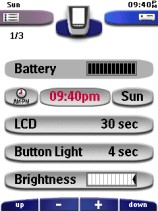|
...Continued from Page 4.
Recharging - insert sophisticated text here (!)
The underside of the remote is almost completely occupied by a large door that conceals a cavernous battery compartment. This is where the ProntoPro's included rechargeable AAA NiMH battery pack connects. You'll also find a [RESET] button, used to reboot the remote in case of difficulty.
With the original Pronto, the desktop charger (which included a compact docking station and an AA NiMH battery pack) was an $80 option. But since the ProntoPro's bright color screen and faster CPU is prone to chewing through batteries faster than a rabbit through a lettuce patch, Philips has sensibly made the docking station part of the standard package. Regular alkaline batteries aren't even a possibility as the pack connects to the remote with a cable. The station itself is larger at 4.6" wide by 6.5" long by 1.5" high (11.7cm by 16.6cm by 3.8cm) and cradles the remote, rather than having it perch on top. I am, however, not completely enamored with the new connecting mechanism. Since the docking station now includes a PC interface passthrough, Philips changed from the original station's "drop it and forget it" connector to a more complicated arrangement with hooks and latches, similar to some cell phones or PDAs.
In order to successfully "dock" the remote, it cannot be simply dropped into place or even slid down the charger's angled surface. Instead, the bottom must be carefully positioned, at a 30 to 45 degree angle, onto two small plastic hooks, then the top swung down. The exact opposite movement is required to detach it from the station. When removing, the remote often caught on the hooks and lifted the front edge of the charger before disengaging. Since these are plastic parts, I am concerned that they will begin to wear or - worse - if someone attempts to place or uncouple the remote improperly, they may break.
Philips does not appear to officially rate the battery life for the ProntoPro, but since power consumption is obviously higher than the TSU2000 while the physical batteries are smaller, it will likely be in the range of "weeks", rather than "months". This is one reason I would have preferred a more "friendly" charging connector. Twin LEDs on the charger indicate the remote's charging status, while readers from parts of the world where 115V/60hz isn't the norm will be pleased to hear that the AC/DC adaptor is removable from the station and uses a standard connector. Philips will also make the TSU6000 available internationally as the SBC-RU970.

The Mode Menu |
There's more than one way...
Despite being targeted towards high-end consumers, where the purchaser will most likely either pay for a professional configuration or do it themselves on a personal computer, the ProntoPro still maintains two separate methods of configuration: with or without a computer. Since all programming options are virtually identical to the Pronto TSU2000, both on the remote and in the PC software, readers acquainted with our review of that remote will find much of the following familiar.

The Setup Menu |
First, we'll cover on-board configuration. The mode menu - the place from where all programming options are accessed - no longer resides at the bottom of the screen. Instead, it is accessed by pressing the icon of the remote at the top. Holding down the same icon for several seconds provides admittance to the Setup Menu. As outlined above, the ProntoPro features three main sections in its interface. The "Home Menu" is where a list of all devices is stored, the "Device Menu" is for actual device controls, while the "Macro Menu" contains automation macros and system timers. Though these distinctions are of little value in ProntoEdit, they play an important role when you're configuring on the base remote. Devices can't hold macros; Macros can't hold learned signals; the Home Menu can't do anything but link to devices.
| 
